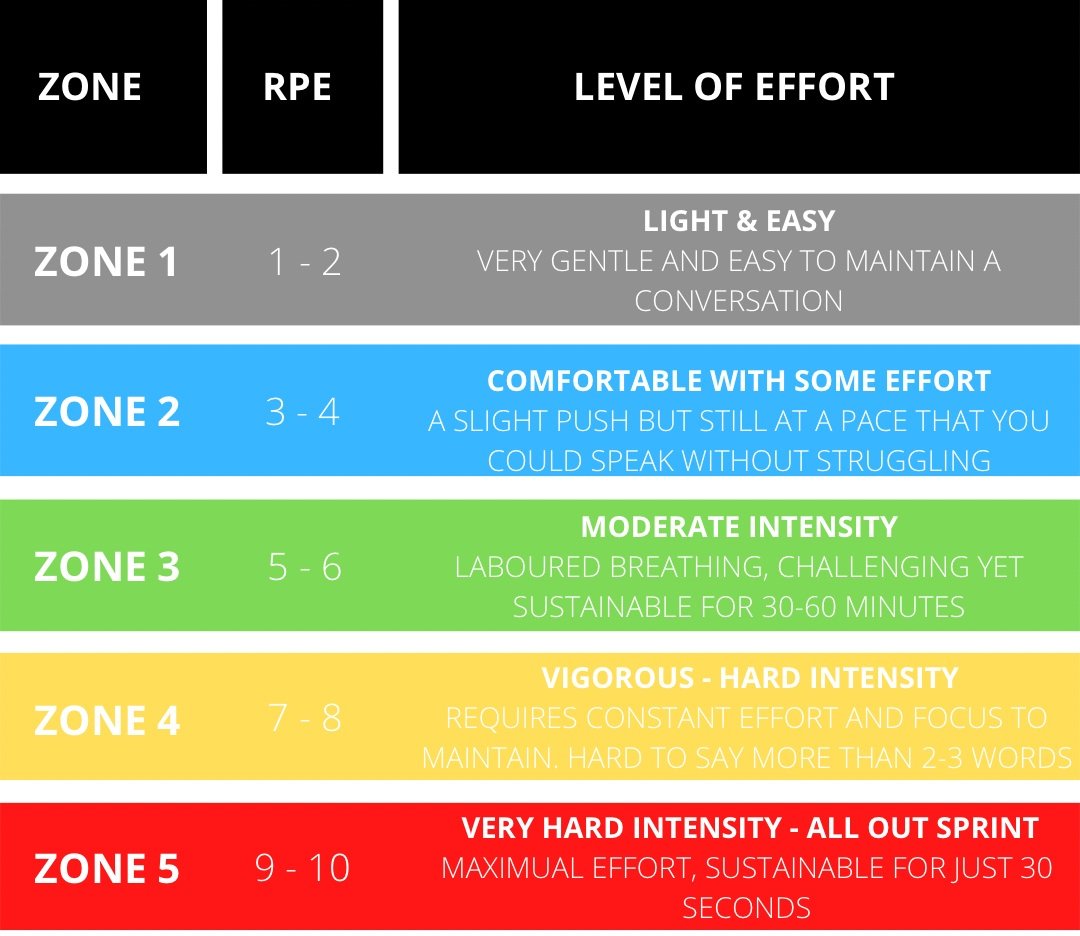Heart Rate & Intensity Zones
Reading time: 6 minutes
As part of this Experienced Runners Programme we are going to ask you to work to certain intensity levels during your running sessions.
If you think back to when you first began running, it is likely that your aim was to increase the amount of time you were able to run for. Your body needed to become conditioned to the movement and your lungs had to be able to take in the oxygen needed and distribute it around your body. When you become a bit more experienced, the training methods must become more scientific. Granted, if you can run 5k but your goal is to run a marathon then going out for a slightly longer run each week is going to work for you and build up your endurance. However, if you are currently running 5k and you want to beat your record time, going out and running the same distance at the same pace each week and hoping for improvements isn’t the most effective way to train. This is why, during the programme, we are going to ask you to run at a variety of intensities in different training zones.
The best and most accurate way to assess the intensity you are working at is by monitoring your heart rate. In this blog we are going to explain how to work out your Maximum Heart Rate (MHR) and then how to calculate the different Heart Rate Zones necessary to ensure you get the most out of your training. As mentioned, heart rate is the most accurate way of determining intensity but if you don’t own a heart rate monitor, there is another method which is more subjective. This method is the ‘Rating of Perceived Exertion’ or ‘RPE’ scale, which will also be explained.
Heart Rate:
Lots of the wearable devices we now have on our wrists show a heart rate reading but the most accurate heart rate monitors have straps which attach across your chest. The heart rate zones you are going to be working at are set by calculating a percentage of your Maximum Heart Rate (MHR), so the first task is to work out your MHR. The most accurate way to do this is to take part in a laboratory VO2 max test in which a participant’s physiological capabilities are analysed by pushing the individual to their absolute maximum. Luckily, there are ways in which we can estimate maximum heart rate without having to go through this process. The most commonly used formula to calculate this is:
220 - your age
This is a good starting point to give yourself a gauge of how fast your heart will beat at it’s top level. However, research has shown that this formula is not perfectly accurate for everybody, especially for those who have been fit for many years or for older people, so don’t be surprised if you notice your heart rate going above this estimated figure.
Once you have calculated your maximum heart rate, you now need your Resting Heart Rate (RHR) . When doing this you are looking for the lowest reading possible. It is therefore important that you do not take it within 1 hour of exercise or a stressful event. It is widely thought that the best time to take your RHR is first thing in the morning before you get up. If this isn’t possible, sit still for 5 minutes and concentrate on your breathing before taking a reading. It can be done using a heart rate monitor or by taking your pulse with your fingers for one minute.
You may now need a pencil and a piece of paper! Using the Karvonen Formula we need to calculate your Heart Rate Reserve which is:
Maximum Heart Rate (MHR) - Resting Heart Rate (RHR)
You can then work out your different training zones. To do this, take your Heart Rate Reserve figure and:
X 0.5 + your RHR (to calculate 50%)
X 0.6 + your RHR (to calculate 60%)
X 0.7 + your RHR (to calculate 70%)
X 0.8 + your RHR (to calculate 80%)
X 0.9 + your RHR (to calculate 90%)
Using me as an example:
I am 42 years old so my estimated MHR is 220 - 42 = 178 beats per minute
My Resting Heart Rate is 60 beats per minute
My Heart Rate Reserve is therefore 178 - 60 = 118 beats per minute
So, 50% of my Maximum Heart Rate is: 118 x 0.5 + 60 = 119 beats per minute
90% of my MHR is 118 x 0.9 + 60 = 166 beats per minute
The table below shows my heart rate zones:
Click here to create your own Target Heart Rate Zone Table. You can print this out and update it with your personal numbers.
When working hard you may notice your maximum heart rate going slightly higher than the estimated figure. Don’t panic if this is the case as using the ‘220 - Your Age’ formula above isn’t going to be exact. It should be noted, we do not expect you to work to 100% of your heart rate at all during this programme. If you find yourself getting above 90%, reduce your intensity down to so your heart rate drops into the desired zone. Be aware of symptoms such as severe shortness of breath, chest pain, dizziness or severe heart palpitations, are all signs that you need to slow down.
Rating of Perceived Exertion (RPE):
If you do not own a heart rate monitor, the best way to estimate the intensity of your run is through an RPE Scale. There are a variety of scales and ways to measure RPE but generally, a scale of 1-10 is regarded as the simplest and also the most widely used. It is a subjective tool and involves you rating how difficult you are finding the run/particular part of the run between 1 (very light) and 10 (maximal effort). It is not as accurate as using a heart rate monitor but it does give you a good estimate of the intensity that you are putting in to the run. Below you can see an RPE scale with descriptions to help you decide on your rating:
If you are going to be using a heart rate monitor during your runs, take some time over the next couple of days to work out your training zones as it will ensure that you are working to the correct intensity and you will be getting the most benefit from the sessions. If you are going to use the RPE Scale, print it off, pin it to your fridge and become familiar with the ratings. Whichever method you use, over the next 10 weeks we are going to get the most out of your time spent running by training in different intensity zones.



